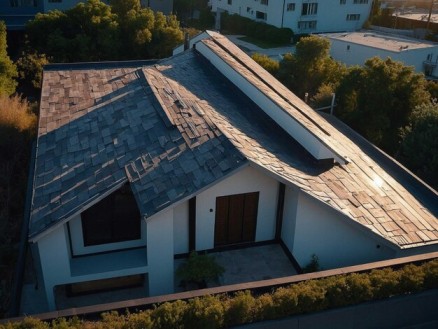The choices of a sloping roof or even the flat roof are basic to computation in the architectural design of the residential family home. This guide provide general and comprehensive information on what is sloping roofs, types of sloping roofs, materials used to build the sloping roofs, advantages of having the sloping roofs, disadvantages and some limitations of the sloping roofs and at long last guide on selecting the best type of the sloping roofs for your house.
What is a Sloping Roof?
A pitched roof additionally has an inclination angle higher than ten degrees from the horizontal. Preferred in the region where rainfall or snowfall is high, a sloping roof provides good drainage; it is also preferred in regions with moderate climatic conditions owing to its looks. A sloping roof house has always been associated with a traditional roofing design, but now even-, it creates special designs that use a sloping roof in a modern home.
Types of Sloping Roofs
Sloped roof designs can vary or have different designs which can add to personalized changes in slopes based on preferred looks and construction requirements.
1. Mono-Pitched or Shed Roof
Shed Roof are inclined roof designs that are one-direction and straight forward and require less construction time to be put up. They are good for putting up solar panels for a good shot at getting sunlight exposure.
2. Gabled Roof
Featuring two slopes meeting at the top ridge and thus forming a triangle, the gabled roofs have the options of the cross gabled and the Dutch gabled roofs making it suit the sloping roof design.
3. Hip Roof
A hip roof has a top which is flat and buttressed on all four sides- this is common in countryside regions. Different types include double hip and pyramidal hip roof, which is ideal based on the different floating sloping roof elevation.
4. Mansard Roof
With use of flat and sloping roofs this European style offers a lot of designs though time consuming and costly hence rarely used in the country.
5. Sawtooth Roof
With more than one ridge or slope this type enables natural light into the house but is expensive and requires much maintenance.
Material Options for Sloping Roofs
There are various types of sloping roofs and each of these materials is designed in a manner that fits the tastes and structural needs of a homeowner.
- Concrete Sloping Roof: Cheap but needs early strength of concrete, proper curing, and good quality surface application to avoid cracks and leakage.
- Tiled Sloping Roof: Used in clay, concrete and metal, tiles can be used to add design and creativity but it is not suitable for changes in climatic conditions.
- Sheet Roof: Typical in industrial types; metal or plastic sheets may cause heat build-up, therefore not suitable for houses.
- Wood Sloping Roof: If well treated it lasts long but requires use of matured timber so that they do not get rotten easily.
Limitations of Sloping Roofs
While ideal for the rainy areas, the sloping roofs have their drawback when it comes to construction of new urban homes.
- Water Management: Slope may need more gutters in case of large amounts of water flow.
- Leakage/Seepage: Waterproofing becomes difficult particularly at non-concrete inclined roofs likely to cause water related problems.
- Maintenance Access: With such structures as the sloping roofs, it is sometimes very cumbersome to carry out repair works with no catwalk in place.
- Usability: As compared to a flat roof, a slope reduces the common area and terrace area, although it has its benefits.
Sloping Roof Design
Choosing the correct slope of the roof is influenced by the aesthetic value, weather conditions, climatic conditions, and appropriate engineering features. Proper waterproofing, planning on how to access the roof and calculating the angle of the sloping roof is crucial to provide a good looking roof that is also long lasting. It is advised to get in touch with an architect or get a structural engineer in order to come up with the best design and materials of the slanted roof. Consult Walls and Dreams for construction services in construction services to have your dream home with the best sloping roofs.
After reading this article, you will have learned fundamental elements of sloping roof designs and what materials you need when constructing such a house.


